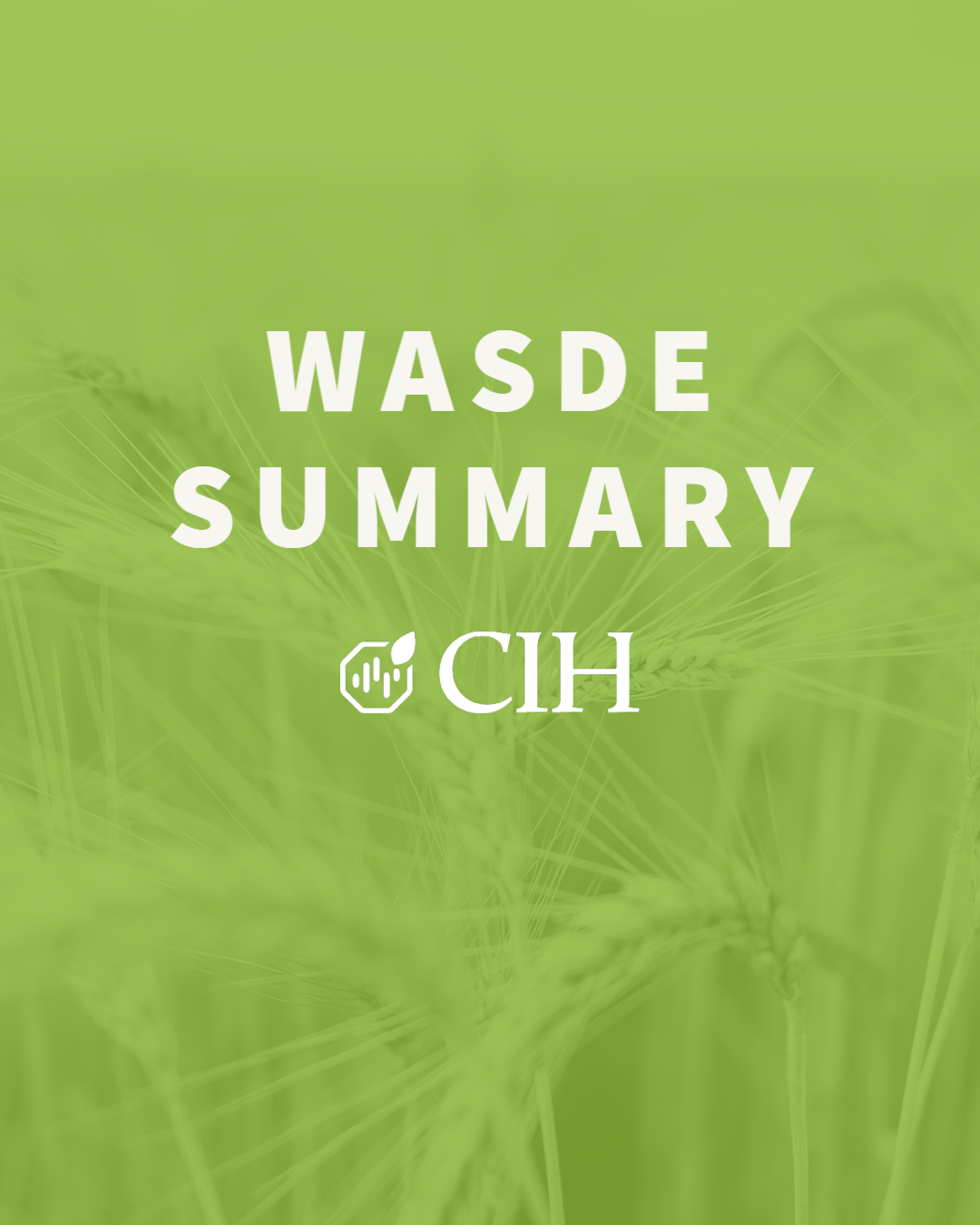
September 12, 2023
SEPTEMBER 2023 WASDE REPORT SUMMARY & NOTES:
The September WASDE report was bearish relative to trade expectations for corn, neutral for the soybean complex, and supportive for wheat. While the corn and soybean yields were cut from the August forecast as expected, USDA raised the planted and harvested acres for both crops which offset the impact to production. World wheat production and ending stocks were lowered sharply from last month which was beyond pre-report market expectations. Market attention will continue to focus on late season weather impacts to crop maturation and harvest conditions across the Midwest, with low water levels on the Mississippi River affecting barge transportation and local basis.
For corn, the domestic 2023/24 balance sheet raised both planted and harvested acreage by 800,000 each to 94.9 and 87.1 million, respectively. As expected, yield was reduced from last month by 1.3 bushels per acre to 173.8 which was 0.5 bushels above the average trade estimate but within the range of pre-report expectations between 171 and 175 bushels per acre. Beginning stocks were lowered 5 million bushels from last month and production raised a net of 23 million bushels to 15.134 billion as the increased area and lower yield largely offset one another. No changes to projected usage were made to the domestic balance sheet this month with ending stocks projected up 19 million bushels from August to 2.221 billion. This was 94 million bushels above the average trade estimate but within the pre-report range of estimates between 1.830 and 2.399 billion. The season-average farm price was left unchanged at $4.90 per bushel. The global corn balance sheet featured only modest changes from last month with world production forecast up 790,000 MT from August, but world ending stocks up 2.94 MMT to 314 MMT. This compares to the average trade estimate of 310.3 MMT pre-report and was above the range of expectations between 305.0 and 313.8 MMT.
Total U.S. corn production of 15.134 billion bushels would be the second highest ever next to the record crop of 15.148 billion bushels in 2016-17:

Harvested area of 87.1 million acres would be the highest since 2013-14:

At 173.8 bushels per acre, corn yield would be just above last year’s 173.3 and below trend:

The domestic soybean 2023/24 balance sheet slightly raised the planted and harvested acreage figure by 100,000 each to 83.6 and 82.8 million acres, respectively. Yield was lowered as expected to 50.1 bushels per acre, down 0.8 bushels from August and in line with the average trade estimate of 50.0 bushels with the range of forecasts between 49 and 51 bushels per acre. The production estimate was lowered 59 million bushels from August to 4.146 billion bushels, which along with beginning stocks down 10 million bushels from last month due to higher old-crop exports reduced total new-crop supply by 70 million bushels. Domestic crush was lowered 10 million bushels from last month to 2.29 billion while exports were cut 35 million bushels from the August projection to 1.79 billion. The new-crop ending stocks forecast of 220 million bushels was down 25 million from last month but within the range of pre-report estimates between 170 and 255 million with an average estimate of 213 million bushels. The new crop domestic season-average soybean price forecast was raised $0.20 from last month at $12.90 per bushel. The global soybean balance sheet reflected only modest changes from last month with China’s imports raised 1 MMT to 100 MMT and Brazil’s exports raised 500,000 MT to 97 MMT. USDA cut the import projection for both the EU and Southeast Asia by 300,000 MT each to 13.8 MMT and 9.94 MMT, respectively. Global ending stocks were cut 150,000 MT to 119.25 million, slightly higher than the average pre-report estimate of 118.5 MMT but within the range of expectations between 116.4 and 120.8 MMT.
Soybean production of 4.146 billion bushels would be the lowest since 2019-2020:

Soybean yield at 50.1 bushels per acre would be up only slightly from last year’s 49.5 bushels and below trend:

New crop soybean stocks-to-use at 5.2% would be down 0.6% up from last year and the lowest since 2015-16:

The 2023/24 domestic wheat balance sheet was completely unchanged from August with only offsetting by-class changes on exports noted by USDA. Global wheat supplies however are projected to decline 7.2 MMT from last month with lower production in Australia, Canada, Argentina and the EU only partially offset by an increase in Ukraine. Australia’s production is forecast down 3 MMT from last month to 26 MMT as dry weather this past month in Western Australia, New South Wales and Queensland lowers yield prospects. Canada’s production decreased 2 MMT from August to 31 MMT as model-based forecasts by Statistics Canada indicate lower yields arising from dry conditions across the Prairies. Ukraine’s production increased 1.5 MMT from August to 22.5 MMT, with exports from Russia and Ukraine projected up 1 MMT and 500,000 MT, respectively, to 49 MMT and 11 MMT. USDA raised feed and residual use by 1 MMT for both China and the EU due to wet weather during harvest that is expected to result in higher amounts of lower-quality wheat used for feed. World ending stocks were reduced 7 MMT to 258.6 MMT, well below the average trade estimate of 265 MMT and outside the range of analysts’ pre-report estimates between 261 and 267.9 MMT. USDA notes that this would be the lowest world ending stocks figure sine 2015-16 and results primarily from tighter ending stocks for several major global wheat exporters.
Australia’s wheat exports at 19 MMT are projected down sharply from last year’s record 32.5 MMT:

Although Ukraine’s exports would be the lowest since the 2014-15 crop year:
